- Homepage
- Our green kitchen
- Homemade Hummus With Lemon Pulp
Homemade hummus with lemon pulp
Homemade hummus with lemon pulp also needs freshly-roasted cumin seeds; and tahini which is a sesame paste.
We humans need rather less than 1g of protein per kilogram of body-weight from our food; more in the young and the elderly. So the average person would want around 60 or 70 grams each day.
A 100 gram steak would provide nearly half of that, for example.
Food
Steak
Chickpeas
1 egg
Weight
100g
100g
60g
Protein
25g
19g
9g
Cost/60g protein
R24
R3.20
R13
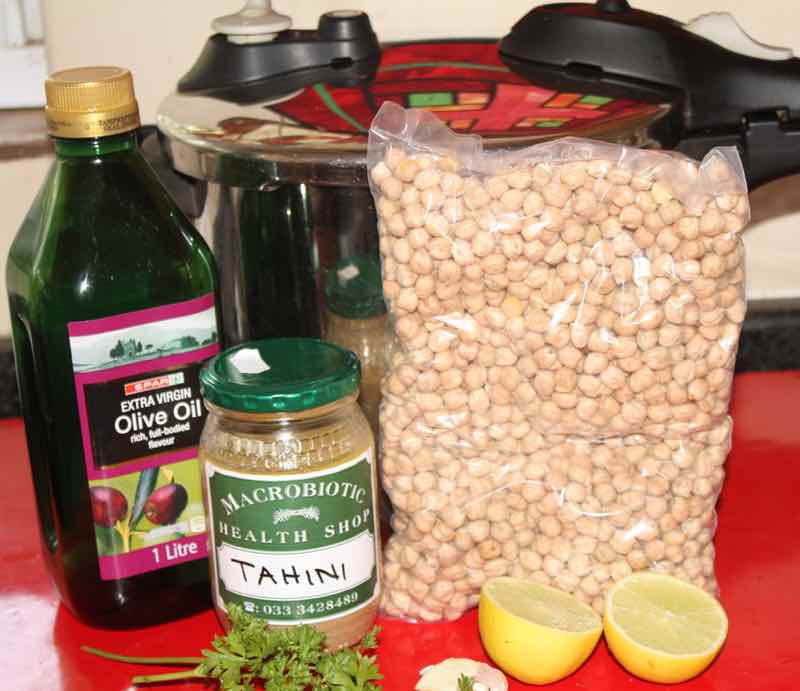
Ingredients
- 1 cup frozen chickpeas
- 1/2 lemon including the pulp and a little of the zest
- 1 TBSP tahini-paste
- 1/2 tsp freshly-roasted cumin seeds
- 3 TBSP unchlorinated water
- 1 TBSP olive-oil
- 1 clove garlic
- Sprig of parsley
- 1 peppadew or slither of chili is optional.
- 1/2 tsp salt
100g of steak would cost around R12 but that weight of dry chickpeas less than one rand if you buy these legumes by the kilo; soak overnight, pressure-cook and freeze them for convenient use later. From a can the price is four times as much, about the same as an egg.
Most families are feeling the financial pinch right now so for about one tenth of the price of meat or eggs you can put the same amount of protein on the table; with zero cholesterol if that’s a bother for you[3].
So it comes as no surprise that chickpeas are the chief source of protein around the world; along with many other legumes too like beans and lentils.
Legumes have little flavour
There are two important differences though; chickpeas have very little flavour so you have to dickie them up with herbs and spices. Lemons are commonly used.
Incidentally legumes are also the chief source of nitrogen-fixation[6] from the atmosphere. They provide the element that is key to the structure of amino acids, the building blocks of protein in our bodies.
Lightning is the other source.
"When eating doesn’t feel like a hardship, it is easy to stick with it."
- American Test Kitchen
Complete proteins
And secondly chickpeas are not a complete protein; they are rich in lysine but deficient in methionine, two important essential amino-acids that we cannot live without.
So vegetarians would add either a grain or a seed to their legumes; they need that methionine. The traditional "stamp corn and beans" comes to mind for South Africans[1], and succotash to Americans[2].
Homemade hummus with lemon pulp uses these principles, supplying all the required essential amino acids by adding a sesame-seed paste called tahini to the chickpeas; and various seasonings to make it more palatable. It is a staple in the Mediterranean, known for its healthy food.
We have at least one large tablespoon every single day, making a green salad far more interesting; about 3 grams of protein and 2g of unrefined low GI carbs. Vegans would have extra.
Satiety
Legumes are known for their satiety; they appease that gnawing hunger pang far more satisfactorily than a packet of chips, cookie or a cola. A tablespoon of hummus at 11am also won’t send your blood glucose into orbit as those other snacks may.
The coronavirus is targeting folk who are insulin-resistant. That's 40% of those enjoying the "industrial diet;" typical grocery store food. Staying away from refined carbs at this time is more important than ever.
So let's get back to homemade hummus with lemon pulp. Most recipes recommend only the juice; but then you are discarding more than half of the very important nutrients that are to be found in citrus. Use the whole fruit and some of the zest too, bar the pith which is very bitter; that we do toss into the compost bin.
Today I am putting in a small push for more of a largely unknown phytonutrient called beta-cryptoxanthin; I hadn't heard of it until recently. It is the most powerful substance known to scientists to help prevent the early onset of dementia; the richest source is your lemon pulp, and other citrus too. More than half is lost if we use only the juice.
It's scary that 11% of those over 65 who are enjoying typical grocery store food are suffering from Alzheimer's Disease; that's massive. Your homemade hummus with lemon pulp is part of the solution. Read more about the solution to the Big A at this page on lifestyle and ideal body weight.
You can buy hummus in the supermarket. But there’s a massive ten times mark up in price; then the protein is twice as expensive as steak.
It costs around R15 to make a whole kilogram of your own homemade hummus with lemon pulp in just five minutes.
Lemon zest
Lemon zest is the outer part, the rind that contains the fruit's natural oils; the exciting stuff that contains the essential fragrance which we associate with citrus. From a lime the scent is rather different.
These natural oils give to your cooking the most concentrated flavour of a lemon; we will use it to enhance the taste of our homemade hummus. Chickpeas let's acknowledge are rather dull.
Like the shell of a nut, the bran covering a grain of wheat and the skin protecting a watermelon, the zest keeps oxygen out from the important phytonutrients hidden within; a kind of air and water-tight container.
You can sliver the lemon zest off with a very sharp knife, or even that potato peeler below, avoiding the white pith; it is bitter and to be discarded. Better is the microplane, the cyan-coloured utensil; they aren't expensive and can be used for grating hard cheese, ginger and nutmeg too.
Hold the microplane in your dominant hand, the other end firmly on the chopping board; grasp the lemon in your fist, lightly running it over the sharp teeth. Watch out for your knuckles or you'll find a bit of your own skin in the homemade hummus too.
Experiment with how much zest you like in your hummus; start with perhaps half a teaspoon.
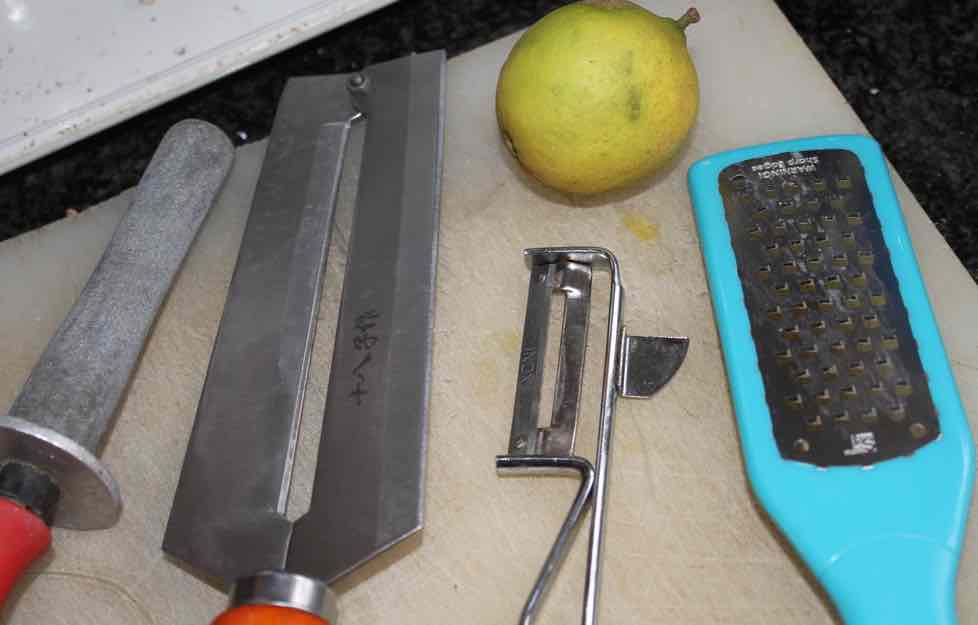
Next week we will go into the details of exactly how to make homemade hummus with lemon pulp. Start by getting a bottle of tahini from a Greek shop, packets of dried chickpeas and whole cumin seeds from an Indian store; olive oil and a few limes.
About R200 will make roughly 3kg of delicious homemade hummus with lemon pulp, with a lot of the olive oil and tahini left over; enough for months.
It takes just five minutes once you are in the groove; what we call slow food, made fast. Marvelous cheap protein, good for us and especially the planet. Legumes and lemons suck up the greenhouse gases, not generate them as cows and humans do.
Homemade hummus with lemon pulp
Homemade hummus with lemon pulp means first soaking, rinsing and then pressure-cooking the chickpeas.
This is really part of a series on the importance of whole lemons and limes, including the pulp and zest but not the pith; and chickpeas as a cheap source of very nutritious protein for the whole family. The other great virtue of hummus for me is that it will turn an otherwise perhaps dull green-salad into a treat.
There is still much anxiety about pressure-cookers; perhaps because of a purple patch on the ceiling that is indelibly imprinted on the memories of many folk from childhood days. But it is unfounded; the modern device is a sophisticated appliance with a foolproof locking system.
I strongly recommend them as they reduce the cooking time by two-thirds, saving electricity too obviously. Get one made of stainless steel; often on sale, they are not so expensive.
Having said that, mindful cooking is just as important as when working with a circular saw or an angle grinder. Most chefs have sliced off a bit of the finger with a sharp knife or burned themselves with boiling-oil before; only do very basic food preparation when tired or upset. Remember to set the safety catch. And don’t turn the stove on high, and then go down the garden for a "bathe in the forest[5]" to unwind.
Step one is to soak a kilogram of chickpeas overnight with plenty of water; rinse several times to remove the phytates.
Cover the chickpeas with boiling water and toss in half a lemon; bring up to pressure for 25 minutes, initially on the highest setting.
Remember to set the safety catch; cool, rinse several times and drain. Then freeze them[4] in cup-sized packets.
Some experts are recommending that you retain and use that cooking liquid; it will give your hummus more flavour. A little anxious about phytates I have not done that.
The cumin
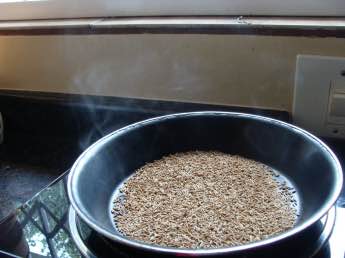
Step two is to roast a few tablespoons of cumin seeds in a heavy-based frying pan, stirring frequently. Before the heavenly incense puts you into a swoon, turn off the heat; don’t let them burn. Blend in a cheap coffee-grinder. Once they have cooled put the powder in a small airtight bottle and store the spice in the fridge.
This is Middle Eastern cuisine so you are probably going to find the freshest ingredients in little Greek and Indian shops.
The slightly arduous part is over and now you have enough chickpeas for a month or more of hummus; from here on, it takes only five minutes. To begin with, I recommend you make a small amount as it does not keep more than a few days; have some daily with your salads, as a side dish and even a tablespoon at 11 o’clock should the tapeworm start biting.
In a clean 500ml container pour about a quarter of a cup of water, a slosh of olive oil and half a tsp of salt; a clove of garlic and a slither of chilli too. Now add a level teaspoon of your cumin powder, a sprig of parsley and perhaps a spring-onion; and a peeled lime or lemon with the pulp and zest. A generous TBSP of tahini completes the ingredients.
I use a peppadew rather than chili simply because I have so many; they are easy to grow[7].
Optional is to add a slice of sweet fruit like mango, and frankly anything else that takes your fancy; chunks of celery, beetroot or freshly-ground nuts, for example. Use a stick blender to froth it all up.
Now add a cup of the thawed chickpeas and blend until smooth; more water if it’s too thick. Cover with a slosh of olive oil; a sprinkle of red pepper flakes is optional. Most legumes have little taste, so dickie them up with your favourite herbs and spices. Finish it in a few days.
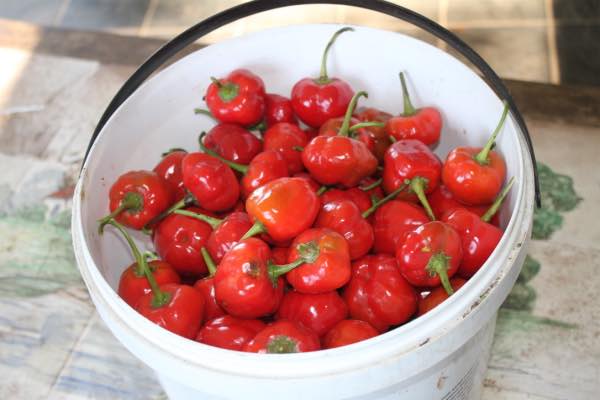
Seeds like sesame from which the tahini is made are rich sources of lignans; these are important phytonutrients that help prevent many serious diseases like breast tumours and heart disease.
What are lignans will help you understand more of this important subject. Prevention always was and will forever be better than a cure.
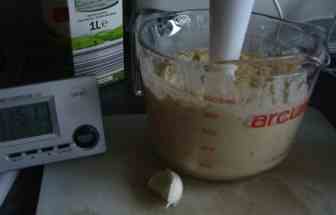
Children and the elderly
Children and the elderly need rather more than 1g of protein per kilogram of body-weight; to prevent stunting and frailty syndrome. Homemade hummus with lemon pulp is perfect for the extra amino acids and beta-cryptoxanthin.
Homemade hummus with lemon pulp is truly one of the "very good" foods; cheap and so easy to make in a jiffy. Every kitchen should have a pressure-cooker anyway.
When browsing use right click and "Open Link in New Tab" or you may get a bad gateway signal.
The material expressed on this page is gleaned from the nutritional and environmental literature; it is clearly referenced. A plain distinction is made between the author's opinion and that which is scientifically proven. When in doubt consult your health professional.
To suggest a correction or clarification, write to Dr Bernard Preston here. Contact.
Newsletter
Our newsletter is entitled "create a cyan zone" at your home, preserving both yourself and Mother Earth for future generations; and the family too, of course. We promise not to spam you with daily emails promoting various products. You may get an occasional nudge to buy one of my books.
Here are the back issues.
- Lifestyle and ideal body weight
- What are ultra-processed foods?
- Investing in long-term health
- Diseases from plastic exposure
- Intensive lifestyle management for obesity has limited value
- A world largely devoid of Parkinson's Disease
- The impact of friendly bacteria in the tum on the prevention of cancer
- There's a hole in the bucket
- Everyone is talking about weight loss drugs
- Pull the sweet tooth
- If you suffer from heartburn plant a susu
- Refined maize meal and stunting
- Should agriculture and industry get priority for water and electricity?
- Nature is calling
- Mill your own flour
- Bake your own sourdough bread
- Microplastics from our water
- Alternative types of water storage
- Wear your clothes out
- Comfort foods
- Create a bee-friendly environment
- Go to bed slightly hungry
- Keep bees
- Blue zone folk are religious
- Reduce plastic waste
- Family is important
- What can go in compost?
- Grow broad beans for longevity
- Harvest and store sunshine
- Blue zone exercise
- Harvest and store your rainwater
- Create a cyan zone at your home
Did you find this page interesting? How about forwarding it to a friendly book or food junkie? Better still, a social media tick would help.
- Homepage
- Our green kitchen
- Homemade Hummus With Lemon Pulp
Address:
56 Groenekloof Rd,
Hilton, KZN
South Africa
Website:
https://www.bernard-preston.com